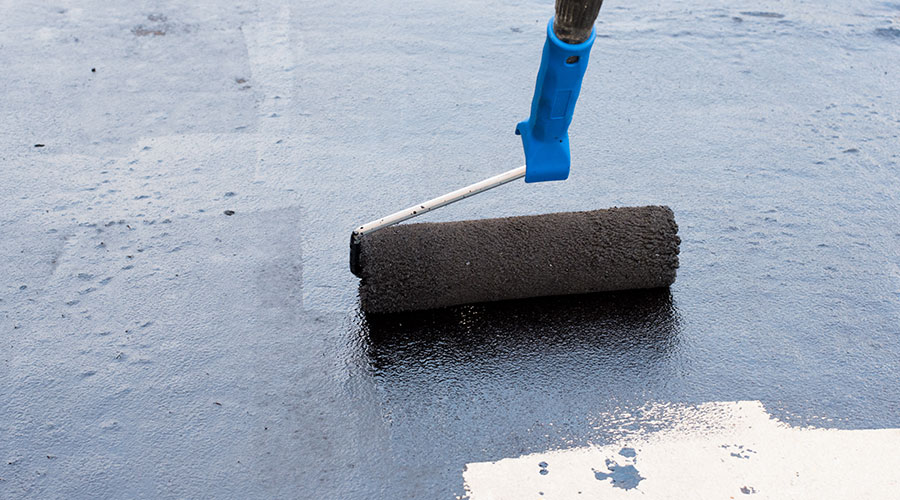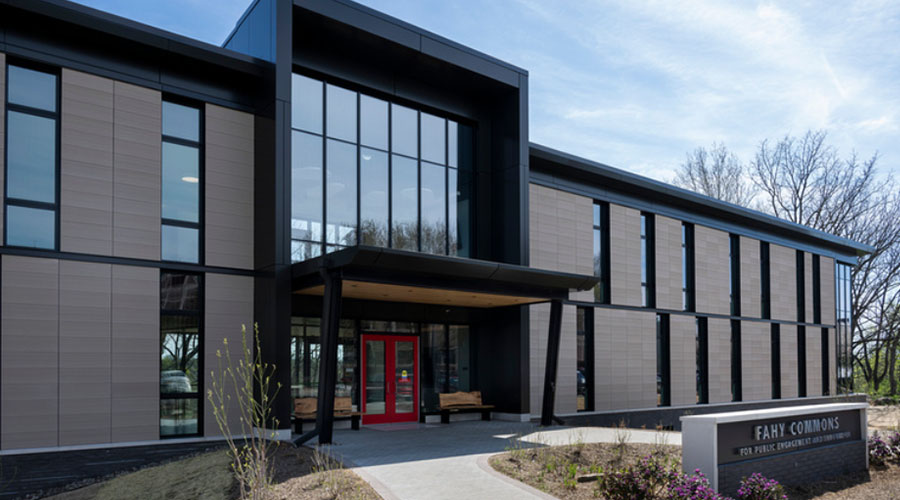REPORT PREPARED FOR THE ROOF CONSULTANTS INSTITUTE
Finding the Right Roofing System
Emerging roof technologies add options for facilities executives
No one roofing system meets every building’s needs, which is why there are so many varieties from which to choose. The challenge for facilities executives is making sure the roof chosen is the correct one for their building.
Emerging roof technologies complicate product selection. Correctly applied, these products may provide performance improvements and cost-saving benefits initially as well as over the life of the roof. Knowing what technologies to consider and what roofing applications are best suited for particular buildings makes selection a complex matter.
Identifying the right system is important for either roofing a new building or reroofing an existing structure. But the latter is a more difficult process, and one that adds another layer of issues to the question of roof system selection.
Spending Wisely
“Reroofing is one of the biggest capital expenditures that a facilities executive faces,” says Thomas Hutchinson, president of the Roof Consultants Institute (RCI) and principal of Hutchinson Design Group. “And the process can be incredibly disruptive, interrupting the work day with noise, dirt, dust, noxious fumes, damaged cars and even windows. Reroofing can be a traumatic experience and you could end up with water leaking through after the job’s done.”
Helping facilities executives through the wide range of issues is the role of the independent roof consultant. Often an architect or engineer, the roof consultant prepares appropriate specifications so that contractors are bidding with identical job parameters. As the owner’s representative, the independent roof consultant can help define the scope of work, evaluate bids and supervise the roof’s construction.
“Roofing contractors want to put on good roofs,” says David Hawn, president of Dedicated Roof and Hydro Solutions. “Manufacturers want to produce roofs that will perform well. But many times when problems occur, it’s because something was overlooked. Even with the best intentions, some things can slip through the cracks because roofing is a human process.”
Self-adhered Membranes
One relatively recent roofing improvement is the development of self-adhered modified bitumen and other self-adhered membrane roofing products. In the case of modified bitumen, the need for hot kettles filled with 400-degree Fahrenheit asphalt on the rooftop is eliminated, making the workplace safer. Noxious fumes that may distract or cause health issues among workers and building occupants are also eliminated.
Luther Mock, president of Foursquare Solutions, plans to use self-adhered modified bitumen on several structures in Florida that suffered hurricane damage. “The buildings feature a very contemporary design and the roofs contribute to the aesthetics of the buildings,” says Mock. In some sections of the roof, the self-adhered modified bitumen is the best solution for the structure, while in other sections asphalt shingles are better. Because the manufacturer offers shingles matching the self-adhered modified bitumen, the best roof for each section of the building can be applied, while also offering an aesthetically cohesive appearance across the roof.
For self-adhered membranes, Gary Cattel, president of Roof Engineering, says hospitals, schools and buildings with geometrically configured roofs may be good candidates.
Another application where self-adhered membranes prove helpful is on high-rises in urban settings, says John Gimple, president of Gimple Roof Engineers. “Typically, these buildings have freight elevators, but there’s no place to put a hot kettle and a crane cannot maneuver around the other buildings to get the roofing product to the roof.”
Another technology that has gained market share recently is TPO (thermoplastic olefin or polyolefin). Although TPOs are available in black and light gray, a popular color is white, suitable for buildings that have a high number of cooling days. Some poor performances of TPOs were reported in the late 1990s, but there now is an ASTM standard for them and the newer formulations seem to be performing more consistently.
Cool Roofs
Cool roofing describes a whole class of roofing materials that help reduce summer air conditioning. Typically, these roofs are light colored with a smooth texture, according to Patrick Downey, president of Merik.
On a high-end furniture retailer’s store in Macon, Ga., the original dark-surfaced, built-up roof was torn off and replaced with 1.5 inches of rigid foam insulation and a mechanically fastened white TPO membrane.
“At this particular store in the summertime, the air conditioning would start at 9 a.m. and run continuously,” says Downey. “As the white roof system was being installed, people in the store could actually feel the temperature difference. Now, the air conditioning cycles on around 10:30 and cycles on and off throughout the day, shutting down earlier in the evening.”
Recognizing the benefits of cool roofs, a number of areas are adopting codes and standards for cool roofs. For example, Chicago’s Department of Buildings adopted Energy Star as part of the city’s building code for buildings after 2008. A new part of California’s Title 24, which takes effect this year on Oct. 1, sets roof reflectivity at 70 percent and emissivity at 75 percent for all nonresidential construction unless the building envelope’s energy conservation is increased to compensate for an alternative roof. The American Society of Heating, Air Conditioning and Refrigeration Engineers (ASHRAE) has the same requirements under ASHRAE standard 90.1 for commercial buildings and 90.2 for residential buildings.
Lightweight Insulating Concrete
A recent development that interests Todd Spore, president of PBK Roof Consulting, is a lightweight insulating concrete decking system combined with surface treatment using dark pellets composed of a blend of bitumen and polymeric binder that have been treated with a release agent. The insulating concrete is installed over EPS insulating board. “Before the concrete is fully set, the pellets are sprinkled on top, then as they are heated up by torching ribbon strips, they start oozing an asphaltic layer that eliminates the need for fasteners and gives a stronger Factory Mutual wind uplift rating,” says Spore. “The system can be used on 22-gauge metal to achieve an FM-190 wind uplift rating.” The reason for ribbon stripping rather than heat torching the full membrane is that lightweight insulating concrete is inherently wet and needs grooves to allow moisture to escape.
PBK is putting down its first application on a two-story oil refinery office building that includes a concrete storm rideout room on the Gulf Coast. “The idea is to keep some personnel and controls on-site to monitor refinery operations even during a category 5 hurricane,” says Spore. When completed, the full roof will be rated FM-190, he says.
Foam Adhesives
For roofing decks where fasteners cannot be used, foam adhesives can provide the necessary wind uplift resistance. But it’s important to choose the proper foam adhesive for the project, says Cattel. “Some foam adhesives don’t have much body,” he says. That’s a problem if the project has deck irregularities, as was the case on a recent project where mechanical fasteners could not be used.
“With a foam adhesive with a high rise, the adhesive foamed up and came in contact with the isocyanurate board insulation,” Cattel says. “We did some testing of the system to make sure it was appropriate for the wind loads in that area. It’s been up about two years now. The roof’s slope keeps the high reflectivity membrane reasonably clean. Best of all, the building’s air conditioning needs have been reduced.”
Curt Liscum, a partner at Benchmark, agrees that polyurethane foam adhesives “have tenacious holding power and solve problems in coastal regions. They are particularly helpful where mechanical fastening is not possible, such as on concrete decks or where you might drive fasteners and penetrate cables.”
Other advantages include low odor production and fewer volatile organic compounds being released than with other adhesive systems. But Liscum stresses that application details are crucial. “These adhesives cannot be put over dust or dirt,” he says.
Selecting the proper roofing solution is just the first step in getting maximum life from the roof. Spore says it’s important to deal with manufacturers with proven successes in the industry. “Make sure they have applications in place so that you can look at the materials and membranes in person,” he says. “We also do plant tours so we can see how they are actually making the product.”
The next step is the application itself. At this point, facilities executives want to be sure they have an experienced professional roof contractor, says Hawn. “When you are looking at newer technologies, you may find some contractors are not experienced in installing the system that you want. They may be good at installing one type of single-ply, but maybe not another type of single-ply. There are lots of opportunities to slip up on a roofing installation. The wrong place for a roofing contractor to be learning how something is applied is on your roof.”
Construction administration, provided by a roofing consultant or other professional parties, is the third step toward a long-lived roof, says Downey. “There needs to be someone who is observing the work as it’s being done, who will do a final inspection and make sure all punch list items are addressed so that you get the best quality.
“If you don’t have these three steps in place, you tend to see problems,” says Downey.
Once the roof is installed, regular inspections and maintenance are crucial to extending the life of the system. “If defects are discovered and repaired when they are discovered, the roof’s life expectancy can be met or exceeded, as opposed to dismally not realized,” Hawn says.
Gimple agrees, noting that applied polyurethane foam “is probably the easiest roofing system to repair, but if it’s not maintained, it can pose a major problem.”
“Facilities executives and building owners need to take responsibility for their roofs,” says Liscum. That includes cleaning the drains and picking up any trash.
Cattel says facilities executives should inspect their roofs twice a year and after any major storms, particularly those involving high winds. “You want to make sure the roof drains are not clogged, there are no branches on the roof and the covers on the air conditioning haven’t blown off,” he says.
Above all, Spore says that it’s important to prevent water from ponding on the roof. “When you eliminate ponding water on a rooftop and encourage positive draining, your roof will be more successful in the long run.”
Related Topics:











